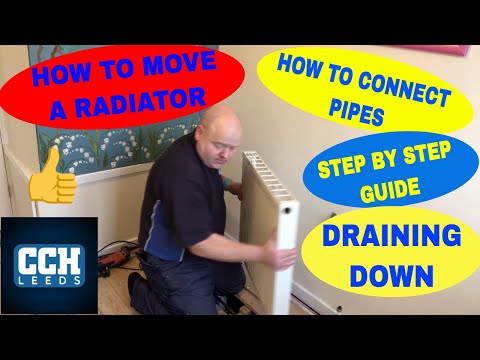DIY guide how to move a rad from one wall to another, Including draining the central heating system down, Lifting floor boards and all the pipework. Moving a Radiator. Radiator Installation, How to drain a heating system. fit Radiator. Today we’ll show you how to move a radiator. So we’ve got a radiator on the wall here and we’ve got the bed. So the radiator is in the way of where we want to put the bed. So we’ll move this radiator and put it on the wall over there. So I’m going to drain the system down and I’m going to cut the boards up. And I’m going to show you different options. So different options of cutting boards up. Different pipe work. So it may be that you want to use plastic pipe. It may be you want to use copper. So I’m just going to show you some different options with that, as well.
So yeah, so first of all I’m going to drain the Central heating system down and I’m going to move all this bed and stuff out of here. So I’ll do that now.
So I’ve got the radiator on this wall, and we wanted to move on it onto this wall here and then that’s the door coming into the room. So as we can see with floorboards, the floorboards go this way. So the pipes, these pipes, this is going to come this way. I would have thought same with this one here. We can see some of the boards have already been disturbed before. See, they’re all smashed, so we’ll take some of them boards up.
We’ve got to look on this side as well. We can see there’s a cut there, so we know that’s been taken up before as well. And then again, there’s a cut there. So we’ll lift these boards up now. So when possible, we’ll always lift the boards that’s been lifted before because they’re already slightly damaged, all cut, and they’re just easier to lift up. But I’m gonna cut some of this floor in a different place, just to show you different options, as well, on cutting it, because it may be that your boards haven’t been up before. But first of all, just lift this so at least I’ve flat bolster. And I’ve just got my hammer and then I’ve got a screwdriver. I try not to use a screwdriver if possible, because they tend to snap the boards, but if you used your big flat one, it just makes it a bit easier.
And you just want to be really gentle as you’re lifting. Stop trying to snap it up because you’ll snap the board, but if you’re careful, you can lift them up without damaging them. Have a look here now. I’ll just show you.
So I can see that the pipes have been been put in. They go this way. And then one thing I would say is always be very wary regarding safety. Never leave boards with nails in like this. So I always take these nails out. It’s very easy for customers, for the kids, or somebody to walk in, or even yourself, and stand on one of these nails, and you don’t want that to happen.
So we’ve got quite a few different options we can use for cutting the boards, to start with. So we could use a jigsaw. Put it in, like that, and cut it like that. I definitely wouldn’t recommend that. But as a last resort, sometimes. Circular saw. So it may be you’ve just got a circular saw, and if you’ve got a circular saw, one thing I’ll say to you is make sure your depth is correct. So adjust your depth to the thickness of the board and then if you cut through and if there was any wires or any pipes or anything close to the joists, then you won’t cut through the joist. So that’s if you’re going to use a circular saw.
I’ve used a circular saw for many years, and it’s only recently that I’ve moved on to using the fein This is brilliant. The good thing with fein is that it’s a neat cut. So you’re only cutting where you need to cut. But with that, you do need to be careful not to cut down too much. So as you feel it cut through, then obviously stop, because if you there’s aught underneath, you don’t want to be cutting into it anyways, underneath. So just be careful if you’re going to use a fein.
So you have different options of cutting the boards up. So just to follow draining this down, I’m going to see which one the flow and return is. So my belief is we try and put the TRV on the floor, if possible. So I’m just going to turn the heating on and then we’ll see which one gets warm first, on these little tails here. So I’ve just put my nest . So I’ve just put heating on there now. So that should come on.
So what you’ll find is when you buy TRVs, and sometimes it goes both ways, which means that the manufacturer will say you can put them on the floor all the way turn, which is okay if you’re doing swaps. Then fine, but if I’m going to fit a new radiator in here now, I’m gonna prep that wall there. It’s easy for me to find out which the flow and return .
Central Heating radiator replacement , Draining down the central heating system. DIY guide , For homeowners and new gas engineers / plumbers doing fast trace training.







